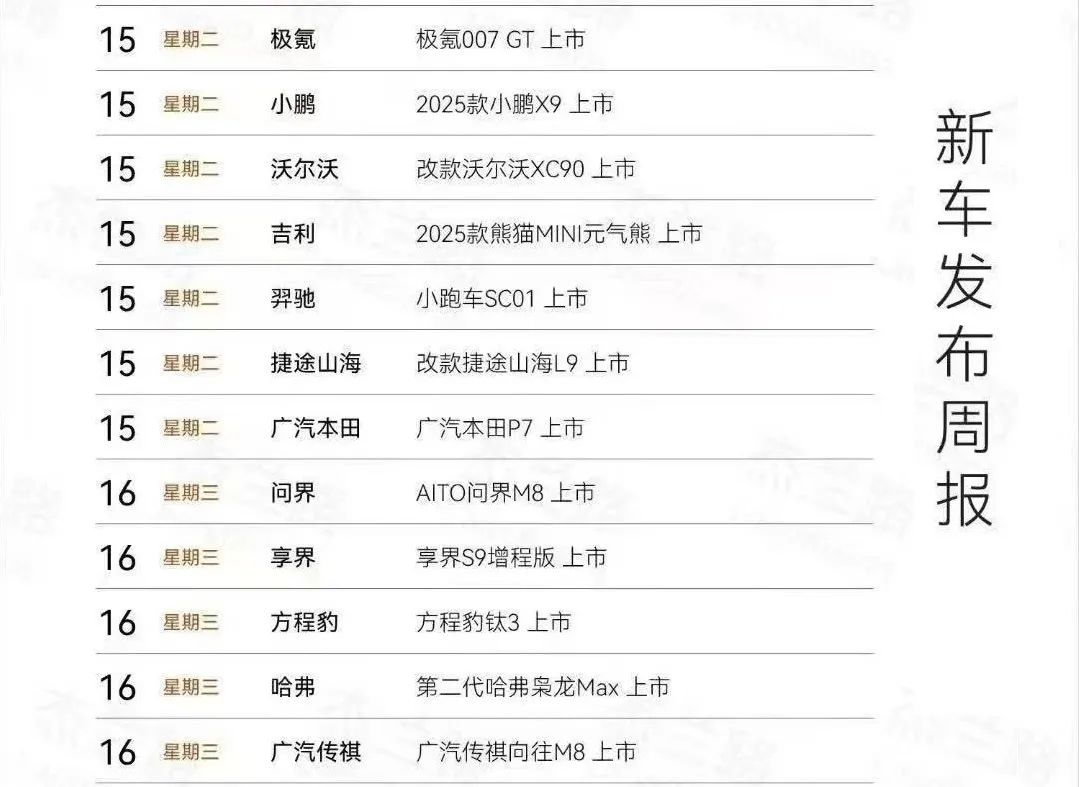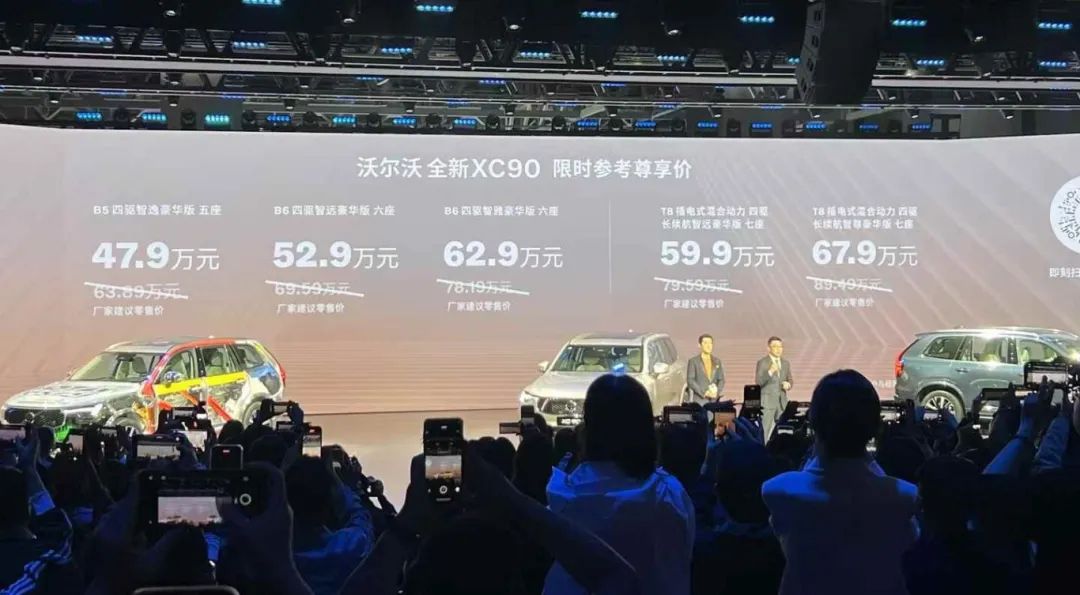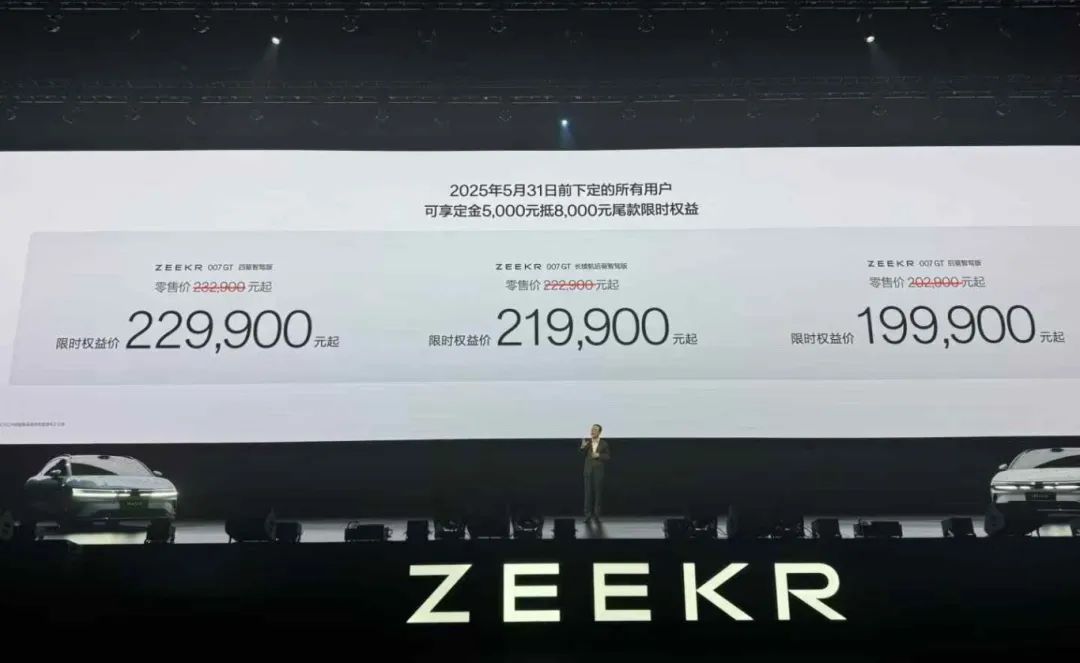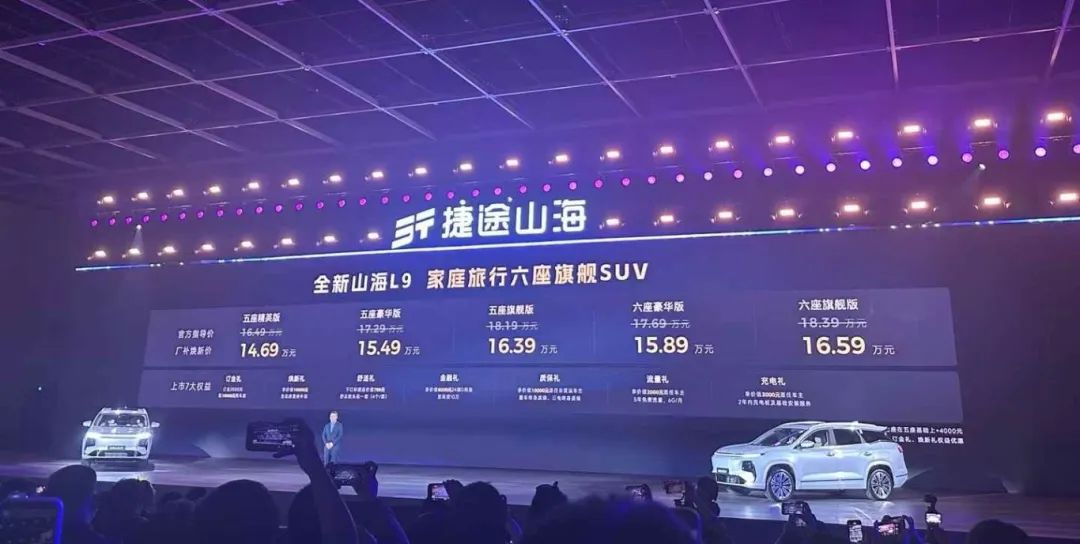24 Hours of Intense Competition: 10 New Car Releases Battle for Survival in the 'Suffocating Internal Market'
![]() 04/16 2025
04/16 2025
![]() 445
445

Introduction
In just a week, the Shanghai Auto Show will once again ignite a fierce market battle, and this year's conditions promise to be no less tumultuous than in the past.
With the Shanghai Auto Show looming just a week away, automakers are eagerly preparing to ignite the spring automotive market. Some have already made announcements, while others have chosen to avoid the peak period and unveiled their key products early. However, with numerous automakers and brands in the Chinese market, even early layouts cannot create significant time gaps, leading to inevitable clustering.
On the evening of April 15th, five brands held press conferences to unveil five new cars: the luxury Volvo XC90, the emerging force Zeekr 007GT and Xpeng X9, the mainstream joint venture Guangqi Honda P7, and the independent brand Jietu Shanhai L9. While some are brand-new products and others are annual model updates, these products are still crucial for each brand and deserve scrutiny from the market and industry.
For instance, will the safety-focused Volvo XC90 be able to reshape its flagship's influence in the market of new energy and new luxury vehicles, such as Li Xiang L9 and AITO M9?
Despite not hitting the right market rhythm or meeting the needs of Chinese consumers, the all-new XC90 places paramount importance on safety, introducing the concept that 'safety is the greatest belief.' After the industry's heated discussions on intelligent driving, batteries, and new energy safety in April, Volvo's emphasis on safety is well-timed. Even if the outcome isn't as Volvo wishes, the voice at the XC90 press conference serves as a correction and purification of industry chaos, at least in terms of safety advocacy and industry adherence.

In particular, Yuan Xiaolin, CEO of Volvo Asia Pacific, unleashed a barrage of criticism against the current chaos in the automotive industry, lambasting marketing-oriented safety, parameter-based breakthroughs, configuration-based hypermarkets, and wishful pseudoscience. He believes that safety has always been a systematic project, and the combination of hardware, software, and data is just the foundation. It requires strong engineering capabilities, long-term knowledge accumulation, and cautious analysis and verification.
However, in terms of products, the visible changes to the all-new XC90 are not significant. This model has undergone a mid-cycle facelift after ten years, with only partial upgrades to the front face and interior, which may not appeal to Chinese consumers who seek novel experiences. Additionally, as an imported vehicle, the XC90 sells only around ten thousand units annually in China, making it difficult to exert a decisive influence.
Fortunately, in terms of pricing, the XC90 is more practical than before, with a guide price ranging from 638,900 yuan to 894,900 yuan, and a reduction of over 200,000 yuan, bringing it to a range of 479,000 yuan to 679,000 yuan. A PHEV version has also been launched, aligning with the price range of AITO M9 and Li Xiang L9, allowing consumers to choose between technology and safety.
The scrutiny for Zeekr's 007GT revolves around whether, re-entering the shooting brake market at its four-year anniversary, Zeekr can use more extreme products and pricing to set a new milestone with the 007GT.
Four years ago, Zeekr entered the shooting brake coupe segment with the 001, selling one out of every ten shooting brake vehicles. In four years, it has opened up a brand-new segment, gradually leading to the emergence of shooting brake or station wagon segments and products in the domestic new energy market, such as the NIO ET5 and Nezha S.
Today, four years later, Zeekr is once again using a tech-savvy shooting brake coupe to mark the next four-year milestone. At this point, Zeekr's understanding of the shooting brake coupe has deepened and sublimated, resulting in a better product than four years ago.
First, the pricing of the 007GT, with a starting price after benefits of 199,900 yuan and a top-of-the-line model of 230,000 yuan, makes it the cheapest Zeekr model besides the Zeekr X. It also comes standard with the Haohan intelligent driving system equipped with LiDAR, Qualcomm 8295 chips across the board, and the CCD Magic Carpet system. Coupled with Zeekr's original design, quality, materials, and safety, it excels in internal electric vehicle competition.

Secondly, the four-year anniversary marks the beginning of Zeekr's transition to the 2.0 era. Zeekr is no longer obsessed with the pure electric race but is exploring more diverse new energy solutions to meet the brand's gradual upward demand and satisfy more user needs with various power forms. For example, the super electric hybrid system initiated by the 9X will become an important driving force for Zeekr's high-end aspirations in the future.
In the 2.0 era, Zeekr has undergone other changes. For instance, in user communication, it has moved beyond the past straightforward and engineering mindset. In terms of products and technology, it focuses on user demand and iterates in an orderly manner, avoiding the situation of launching multiple products in a short period. At the same time, it faces problems and users head-on, establishing a full lifecycle user communication mechanism.
More importantly, as a new luxury brand approaching 500,000 cumulative users, Zeekr will also build a luxury service system for the 2.0 era. It offers industry-exclusive services such as 'unlimited mileage lifetime warranty for the three electrics,' 'free high-speed rescue services,' and 'free road rescue covering any road in China within four years or 100,000 kilometers of new car purchase.' Additionally, services like '1-hour quick maintenance, 24-hour quick painting,' free pick-up and delivery, and free maintenance and transportation have been upgraded. Besides product strength, enhancing essential luxury services is also crucial for Zeekr's upward journey.
For Xpeng, the scrutiny is whether, after the declining product image of the M03 and P7+, it can rely on the X9 to enter the Hong Kong MPV market and gain a golden reputation, thereby awakening the value of the Xpeng X9 in the luxury MPV market and pulling the brand upward.
Last night, Xpeng kicked off its Global Brand Night in Hong Kong and launched the 2025 model of the X9, maintaining the same price range as before, ranging from 359,800 yuan to 419,800 yuan. Hong Kong and MPVs have a natural connection. In this market, filled with luxury MPVs and influential in defining MPV value, Hong Kong represents the benchmark for MPVs. Launching the X9 into the Hong Kong market demonstrates Xpeng's high status and expectations for this MPV.
As Xpeng's flagship, the X9 has strong product strength and pricing. However, under the competition of the Zeekr 009 and a host of extended-range large SUVs, the upward momentum of the Xpeng X9 is insufficient.

However, Xpeng's biggest challenge is not the X9's poor sales but the cheaper M03, which is increasingly becoming the brand's pillar, gradually pulling down Xpeng's brand image and average selling price. Coupled with the P7 series and G series products, their prices are also declining in the brutal market competition, which is unfavorable for brand building and adherence.
Therefore, He Xiaopeng needs to solve how to maintain Xpeng's upward path so that the brand doesn't devalue compared to NIO and Li Auto. The X9 has become the only breakthrough. Besides products, technology is also crucial. The Kunpeng super electric hybrid system with a pure electric range of 430 kilometers breaks the limitations of pure electric vehicles in the high-end luxury market, similar to Zeekr's approach. Additionally, technologies like L3 autonomous driving and Turing chips have a clear timeline, supporting Xpeng's brand influence.
The scrutiny for Honda's P7 comes after Dongfeng Honda's 'disconnected' pricing of the S7. Guangqi Honda has set a fixed price of 199,900 yuan for the P7. Can this seemingly persuasive price reverse the stereotype of Honda and joint venture electrification?
In fact, compared to the Dongfeng Honda S7 launched 40 days ago, which sold for a starting price of 259,900 yuan, the homologous Honda mid-size pure electric vehicle, the Guangqi Honda P7, has seen a direct price drop of 60,000 yuan. This shows that mainstream joint venture brand Honda is trying to understand the pricing system and style of the Chinese market. After the P7's launch, Dongfeng Honda's S7 also adjusted its sales price and benefits, extending this preferential price guarantee to existing car owners, demonstrating Honda's desire for change. Sometimes Honda can be very harsh on itself.
As a mature joint venture automaker, Honda's previous courage to set a price of 260,000 yuan reflects its confidence in the product's worth. This confidence stems from investing costs in areas crucial for long-term use but difficult for users to perceive, refining handling details through a four-year development cycle, and maintaining a strong adherence to the supply chain, durability testing, collision safety, and other aspects.

However, market feedback and user voices are more important. This time, the two Hondas withstood cost pressure and adjusted prices. This is a direct manifestation of 'listening to advice,' requiring courage and demonstrating Honda's perseverance and adherence in the new energy battle. From a cost perspective, prices below 200,000 yuan may not be sustainable.
On the other hand, Honda hopes to expand its user base by lowering the purchase threshold and focusing on the value of full lifecycle services, better utilizing large-scale market feedback to nourish technological iterations. This long-term development approach represents Honda's counterattack strategy for joint venture electric vehicles.
Finally, there is scrutiny for Jietu's Shanhai series. The Shanhai L9 bears the heavy responsibility of lifting Jietu's family travel sequence upward. This time, the Shanhai L9 has been relaunched with a price reduction. Can it change the fact that L9 has been at the bottom of the brand's internal rankings for the past six months?
First, from the name alone, the all-new Shanhai L9 sounds like it's in the same tier as the Li Xiang L9. In terms of front face design, six-seat layout, zero-gravity seats, and other aspects, it leans towards the Li brand and is a new energy product. However, in reality, its size and positioning are closer to the Li Xiang L6, and the price is tens of thousands of yuan cheaper, accurately capturing consumer psychology. With a price range of 146,900 yuan to 165,900 yuan, it has dropped by nearly 20,000 yuan compared to the guidance price, fully embodying the cost-effective approach. Coupled with support from the Chery Group and the rapidly growing Jietu Automobile, it looks promising.
However, looking at sales over the past year and a half, the Shanhai L9 has performed lukewarmly. In the past six months, it has been the second-to-last model in Jietu's sales. This price reduction and renewal are necessary as Jietu aims to reverse its declining trend since last year.
Secondly, as the positioning for family travel and hybrid mobility, the Shanhai L series has always performed worse in sales than its boxy car models. This is not only due to competition but also Jietu's need for breakthroughs in brand premiumization. As an extension of the brand towards family travel, it faces numerous competitors and significant upward pressure, making it challenging to further elevate the brand.

In the internally competitive market, every brand must respond to scrutiny from the market and industry with tangible products. The answer will be verified by the market and consumers after the new products are launched. However, the harsh reality is that before these products have a chance to properly express themselves, the next round of new products arrives in a 'daily update' manner, constantly overshadowing yesterday's voices.
Following the 15th, five more products will hit the market on the 16th, including AITO M8, Enjoy S9 Extended Range, FANGPENG Titan 3, Haval Xiaolong MAX, and GAC Motor Xiangwang M8. One after another, more significant products continue to be thrown into the internal competition of the market. In just 24 hours, ten heavy-hitting products have been introduced.
As netizens put it, 'There are too many products, and consumers are not enough.' With new car launches day after day, year after year, some products will be sought after and spark industry fever, while others will remain silent and stagnant after their launch. In the Chinese automotive market, where more players are clustered, liveliness is accompanied by suffocating internal competition. Who can smoothly survive it?
Editors-in-Charge: Li Sijia & He Zengrong






